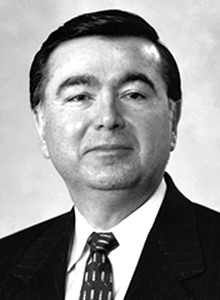
Edward G. Boehne
- President, Federal Reserve Bank of Philadelphia, 1981–2000
Edward G. Boehne served as president of the Federal Reserve Bank of Philadelphia from February 1, 1981,1 until his retirement on May 31, 2000.2 He is the longest serving president in the history of the Reserve Bank.
A native of Evansville, Indiana,3 Boehne earnedfour degrees from Indiana University, including a doctorate in economics. He started with the Philadelphia Fed as a research economist in 1968 and steadily rose through the ranks working on projects such as the Bank’s monthly Manufacturing Business Outlook Survey.4 He became an officer of the Bank in 1970, vice president the following year, and a senior vice president in 1973.3
Boehne was selected as president in 1980, nearly a decade after he first began to participate in Federal Open Market Committee (FOMC) meetings as an economist.5 Boehne's tenure at the Bank overlapped with significant developments in economic conditions at the local and federal levels. These include a series of takeovers of banks throughout the Third Federal Reserve District by larger rivals as well as the national banking crisis that led to the passage of the Federal Deposit Insurance Corporation Improvement Act of 1991. He was a consistent advocate for local banks and the communities they serve, and he often highlighted at FOMC meetings the economic conditions faced at the local level. During much of his tenure, the Fed's challenge was to bring inflation down from the double-digit rates of the late 1970s.6 Always a pragmatic monetary policymaker, Boehne was famously an advocate of "opportunistic disinflation"—bringing inflation down gradually over successive business cycles.7
He retired in 2000.6
Endnotes
- 1 Federal Reserve Bank of Philadelphia. "Annual Report." 1981: 10.
- 2 Edward G. Boehne. "Financial Modernization: Vastly Different or Fundamentally the Same?" Federal Reserve Bank of Philadelphia Business Review, July/August 2000: 3.
- 3 Federal Reserve Bank of Philadelphia. "Annual Report." 1980: 7.
- 4 Michael Trebing and Caroline Beetz Fenske. "'The Philly Fed Index Turns 50 with Steadfast Success." Federal Reserve Bank of Philadelphia Economic Insights, Fourth Quarter 2018.
- 5 Federal Open Market Committee. "Meeting, March 21, 2000: Transcript."
- 6 Dow Jones Newswires. "Philadelphia Fed Chief Boehne To Retire After 18 Years at Post." Wall Street Journal, October 27, 1999.
- 7 Federal Open Market Committee. "Meeting, December 18-19, 1989: Transcript."
Written by the Federal Reserve Bank of Philadelphia as of November 2013 and updated by Ella Needler and Genevieve Podleski as of July 2022. See disclaimer and update policy.



